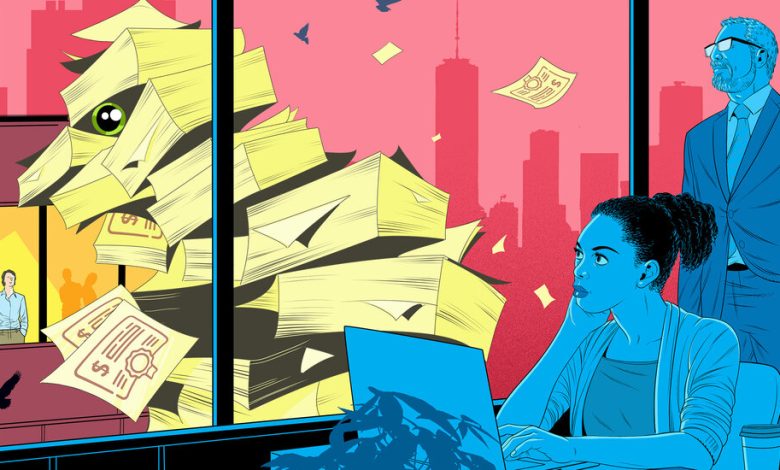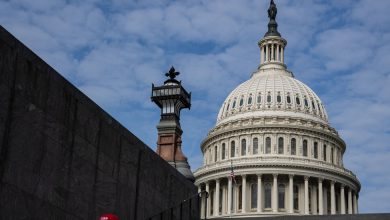The Bond Market, a Sleeping Giant, Awakes

The bond market is stirring. The business world and the Federal Reserve have been forced to take notice. Politicians in Washington may need to do so soon.
After years of low interest rates, yields throughout the vast global bond market are soaring. Just this past week, the yield on the world’s most important fixed-income benchmark, the 10-year Treasury note, briefly exceeded 5 percent.
That clear round number was a psychologically daunting threshold that hadn’t been breached since July 2007, the start of a great calamity.
It was when the collapse of two Bear Stearns hedge funds set off a train of events that culminated in the worst global financial crisis since the 1930s. The world economy faltered. The Federal Reserve cut the short-term interest rates it controlled to near zero. And in the bond market, traders and central bankers drove longer-term yields below 1 percent. Those depressed bond market yields fluctuated but never reclaimed their past heights. Interest rates were so low for so long that businesses and investors barely needed to think about them.
Until now.
Unmistakably, the bond market is back. Yields that were normal until the global financial crisis have suddenly become commonplace again, with enormous consequences. Losses are mounting for speculators who bet, incorrectly, that the rise in interest rates would subside. But for working people who are saving for retirement, and for current retirees, richer rates mean that you can receive a far greater stream of income for your money than has been possible for years. In last week’s column, I discussed how risk-averse people can avoid peril and benefit from higher-rate fixed-income securities with relative safety.
The significance of the upheaval in the bond market is far-reaching. It goes well beyond personal investing, important though that may be.
For a start, just about everyone in finance is looking fairly closely at bonds, and especially at the 10-year Treasury, for clues about a profusion of critical issues.
Here are just a few of the things they’re wondering:
-
Because bond rates determine a range of consumer loan rates, how high will the burden for mortgages, car loans and credit card rates ultimately be?
-
How long can consumers and corporations cope with hefty interest rates without severely altering their economic behavior?
-
Will higher rates cool the surprisingly hot growth of the U.S. economy soon, and bring an end to excessive inflation?
-
Will investors’ ability to obtain safe returns of 5 percent or more a year deter them from buying stocks?
-
Will higher rates further supercharge the already strong dollar, altering trade flows and causing more distress in vulnerable precincts around the world?
The Fed Pauses
Foremost among those reading the bond market tea leaves are Federal Reserve policymakers, who meet next week. At the moment, high bond yields are doing the Fed’s work for it.
As Jerome H. Powell, the chairman of the Federal Reserve, noted in a talk at the Economic Club in New York, while the Fed sets short-term rates, the bond market determines a vast array of longer-term rates, which have appreciably tightened financial conditions in the United States. That should advance a central Fed goal: quelling inflation.
Fed policymakers are widely expected to hold the benchmark short-term interest rate that it controls — the federal funds rate — steady at the 5.25 to 5.5 percent range, at its next meeting on Oct. 31 to Nov. 1. That’s what futures prices show.
Higher long-term interest rates work in parallel with the Fed’s tightening of short-term rates. All these higher rates increase costs and limit business activity throughout the economy. Some estimates find the rising bond market rates to be equivalent to an increase of half a percentage point (50 basis points, in bond market jargon) in the federal funds rate, and perhaps more.
But whether the bond market itself will hold rates steady — or shift them sharply in the weeks ahead — is not yet known.
Financing the Deficit
The bond market isn’t sexy. Bonds involve math, arcane terminology and investment returns that are typically paltry compared with those available in the stock market.
But the bond market plays critically important functions. Without it, governments couldn’t finance their debt.
Consider a few statistics. The world fixed-income market has a value of about $130 trillion, with the United States accounting for 40 percent of it. And U.S. Treasury securities make up almost half of U.S. debt: $25 trillion in August, and counting.
That mountain of U.S. government debt is growing rapidly. The U.S. government deficit, $1.7 trillion, effectively doubled in the last year, requiring the Treasury to auction an extraordinarily large quantity of securities. It must keep doing so for the foreseeable future.
At the same time, the Fed last year shifted from buying Treasuries to shrinking its stash of U.S. debt.
With the Fed gone from the market, bond investors are financing more Treasury debt than ever, and they have collectively been demanding increasingly higher interest rates to do it.
Reincarnation and Vigilantes
The market, as economists say, is seeking a new equilibrium. Put more bluntly, when a mismatch between supply and demand results in rising Treasury yields, politicians in Washington tend to take notice. That happened in the 1990s.
The Clinton administration was forced to pare down some of its progressive ambitions and trim government spending because bond market rates were soaring. The administration embraced fiscal austerity — President Clinton complained to his staff that they had all become Eisenhower Republicans — and moved the federal budget into surplus for several years.
James Carville, the political strategist who was instrumental in getting Bill Clinton elected president, is well known for the slogan, “It’s the economy, stupid.” Another statement of his, published in February 1993 in The Wall Street Journal, is relevant here. He paid reluctant homage to the bond market.
“I used to think if there was reincarnation, I wanted to come back as the president or the pope or a .400 baseball hitter,” Mr. Carville said. “But now I want to come back as the bond market. You can intimidate everybody.”
A decade earlier, Ed Yardeni, who is now an independent economist on Long Island, coined the term, “the bond vigilantes,” when the bond market rebelled against the swelling budget deficits brought about by the Reagan administration’s supply-side economics. “If the fiscal and monetary authorities won’t regulate the economy, the bond investor will,” Mr. Yardeni wrote in 1983.
So far this year, the U.S. government has been unable to get its fiscal policy in order. The federal debt rating was downgraded, the government came close to a collision with its debt ceiling and a government shutdown, and an actual shutdown might well happen next month.
The bond market may not be intimidating everybody quite yet, but it is becoming restive, and it is far too powerful to ignore for long.





